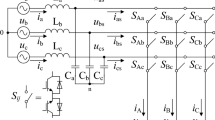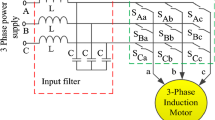Abstract
This paper presents a scheme using carrier-based PWM to control the five-to three-phase matrix converter (\(5 \times 3\) MC). This scheme is based on the equivalent indirect converter model, which models the converter as two independent stages to perform rectification and inversion processes. It presents a comprehensive solution for linear modulation (LM) and over-modulation (OM) operations. The OM operating region is classified into three different regions based on the choice of the rectifier and inverter stages switching functions. These regions of operation are rectifier-side OM (RSO), inverter-side OM (ISO) and both sides OM (BSO). With these schemes, maximum voltage transfer ratio (VTR) of this converter reaches 1.05 in the LM and 1.19 in BSO mode. These values are the maximum possible VTR that can be achieved in \(5 \times 3\) MC. The proposed technique has been implemented using a laboratory setup. Simulation and measured results showed the validity of the given analysis.



















Similar content being viewed by others
References
Dabour SM, Allam SM, Rashad EM (2015) A simple CB-PWM technique for five-phase matrix converters including over-modulation mode, GCC Conference and Exhibition (GCCCE). In: 2015 IEEE 8th, pp 1–4, 6
Venturini M (1980) A new sinewave in sinewave out conversion technique eliminates reactive elements. In: Proceeding of PowerCon
Alesiana A, Venturini M (1989) Analysis and design of optimum-amplitude nine-switch direct ac-ac converters. In: IEEE Transactions on Power Electronics, pp 101–112
Huber L, Borojevic D (1995) Space vector modulated three-phase to three-phase matrix converter with input power factor correction. IEEE Trans Ind Appl 31(6):1234–1246
Dabour SM, Rashad EM (2012) Analysis and implementation of space-vector-modulated three-phase matrix converter. Power Electron IET 5(8):1374–1378
Dabour SM, Rashad EM (2014) A new continuous pwm strategy for three-phase direct matrix converter using indirect equivalent topology. In: Proceedimgs of IET-PEMD conference, Manchester, pp 1–6
Dabour SM, Allam SM, Rashad EM (2014) Space vector PWM technique for three-to seven-phase matrix converters. In: Proceedings of the IEEE 16th International Middle East Power Systems Conference (MEPCON’14), Ain Shams University, Egypt
Gozde H (2015) Comparative analysis of swarm optimization-based control method for direct matrix converter. Electr Eng 97:181–193
Altun H, Sünter S (2013) Modeling, simulation and control of wind turbine driven doubly-fed induction generator with matrix converter on the rotor side. Electr Eng 95:157–170
Mihret M, Abreham M, Ojo O, Karugaba S (2010) Modulation schemes for five-phase to three-phase AC–AC matrix converters. In: Energy Conversion Congress and Exposition (ECCE), 2010 IEEE, 12-16 September, pp 1887–1893
Ojo O, Abreham M, Karugaba S, Komolafe OA (2010) Carrier-based modulation of non-square multi-phase AC–AC matrix converters. In: 2010 IEEE International Symposium on Industrial Electronics (ISIE), 4–7, pp 2141–2146
Abdel Rahim O, Abu-Rub H, Ahmed SM (2013) Space vector PWM for a five to three matrix converter. Applied Power Electronics Conference and Exposition (APEC), 2013 Twenty-Eighth Annual IEEE, 17-21, pp 3246–3250
Ahmed SK, Abu-Rub H, And Iqbal A (2012) Pulse width modulation control of a direct AC–AC power converter with five-phase input and three-phase output. Int J Autom Power Eng 1(8):186–192
Mohapatra KK, Jose P, Drolia A, Aggarwal G, Thuta S (2005) A Novel Carrier-Based PWM Scheme for Matrix Converters that is Easy to Implement. In: IEEE 36th Power Electronics Specialists Conference, 2005, PESC ’05, 16-16, pp 2410–2414
Ahmed Sk, Abu-Rub H, Iqbal A (2011) Generalized duty ratio based pulse width modulation technique for a three-to-k phase matrix converter. IEEE Trans Ind Electron 58(9):3925–3937
Ahmed SK, Abu-Rub H, And Iqbal A (2010) Carrier-based PWM technique of a novel three-to-seven-phase matrix converter. In Presented at the International Conference Electrical Machine ICEM, Rome, Italy, Paper RF- 004 944, September 3–6
Hassanin NAM, Fletcher JE (2007) Analysis three- and five-phase permanent magnet machines supplying diode bridge rectifiers for small-scale wind generators. In: International Conference on Power Engineering, Energy and Electrical Drives, 2007. POWERENG 2007, 12–14, pp 648–653
Masoud MI (2015) Fully controlled 5-phase, 10-pulse, line commutated rectifier. Alex Eng J 54(4):1091–1104
Iqbal A, Levi E, Jones M, Vukosavic SN (2006) Generalised sinusoidal PWM with harmonic injection for multi-Phase VSIs. In: 37th IEEE, Power Electronics Specialists Conference, 2006. PESC ’06, 1,7, pp 18–22
Allam SM, Dabour SM, Rashad EM (2016) Control of three-to-five-phase matrix converter using carrier-based PWM algorithm. Renew Energy Sustain Dev J 2(2):1–12
Author information
Authors and Affiliations
Corresponding author
Rights and permissions
About this article
Cite this article
Dabour, S.M., Allam, S.M. & Rashad, E.M. A carrier-based PWM scheme for maximizing the voltage transfer ratio of five-phase to three-phase matrix converter. Electr Eng 99, 737–750 (2017). https://doi.org/10.1007/s00202-016-0445-7
Received:
Accepted:
Published:
Issue Date:
DOI: https://doi.org/10.1007/s00202-016-0445-7




